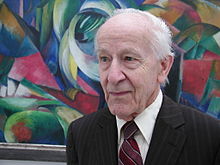Rolf Huisgen

Rolf Huisgen (born June 13, 1920 in Gerolstein , Eifel ; † March 26, 2020 in Munich ) was a German chemist . He was best known for his work on 1,3-dipolar cycloaddition reactions.
life and work
After graduating from the Staatliche Reginoschule in Prüm , Huisgen began studying chemistry at the University of Bonn and then switched to the Ludwig Maximilians University of Munich (LMU Munich). As a student of Nobel Prize winner Heinrich Otto Wieland , he was in 1943 at the University of Munich with the work contributions to the knowledge of the Vomicins doctorate . In 1947 he received his habilitation and became a private lecturer . In 1949 he was appointed associate professor for organic chemistry at the Eberhard Karls University in Tübingen . In 1952 he received a call back to the LMU Munich as a full professor and head of the Institute for Organic Chemistry. Since 1988 he has been emeritus . Rolf Huisgen was a widely cited author of around 590 scientific publications in international journals. Its importance is also shown in the fact that in Germany alone 16 of his students became full professors.
The main area of his research was physical organic chemistry . The focus of his interest was in particular the reaction class of [3 + 2] cycloadditions or 1,3-dipolar cycloadditions , which are often named after him (“ click chemistry ”). The Diels-Alder reaction was known as a typical cycloaddition , in which an alkene reacts with a four-atom diene to produce the six-membered rings. If alkenes are allowed to react with triatomic carbon compounds that act as dipoles with a positive charge at one end and a negative charge at the other end, five-membered rings are often formed, and Huisgen found that there is a reaction mechanism of its own without intermediates or free radicals. Huisgen published these findings in 1963. The dipolar cycloaddition (1,3-dipolar cycloaddition of alkenes or alkynes with 1,3-dipolar molecules such as azides, nitrile oxides or diazoalkanes) is sometimes named after him. The Huisgen pyrrole synthesis is also named after him.
In 2019 the media group Clarivate counted him among their favorites for a Nobel Prize ( Clarivate Citation Laureates ).
Private
Huisgen married his colleague Trudl Schneiderhahn in 1946. The marriage was between Birge Huisgen-Zimmermann , born in 1946 , mathematician and professor at the University of California, Santa Barbara , and Helga Huisgen, born in 1949, interpreter and translator of American literature.
honors and awards
- 1959 admission as a full member of the Bavarian Academy of Sciences
- 1960 admission to the American Academy of Arts and Sciences
- 1961 Liebig Medal of the Society of German Chemists (GDCh)
- 1964 member of the Leopoldina
- 1965 Lavoisier Medal from the Société Chimique de France
- 1975 Roger Adams Award from the American Chemical Society
- 1979 Otto Hahn Prize from the Society of German Chemists and the Achema plaque
- 1982 Bavarian Order of Merit
- 1984 Bavarian Maximilian Order for Science and Art
- 1985 corresponding member of the Heidelberg Academy of Sciences
- 1989 member of the National Academy of Sciences
- 1990 foreign member of the Accademia Nazionale dei Lincei in Rome.
- 1991 honorary membership of the GDCh
- 2002 Honorary Professorship at the St. Petersburg State University
- 2006 honorary membership of the Chemical Society of Japan
- 1975 - 2010 honorary doctorates from the Universities Complutense Madrid (1975), Freiburg (1977), Erlangen-Nürnberg (1980), Würzburg (1984), Regensburg (1985), the State Technological Institute Saint Petersburg (1993) and the Free University of Berlin (2010)
Fonts
- Rolf Huisgen, Rudolf Grashey , Jürgen Sauer : Cycloaddition reactions of alkenes. In: Saul Patai (ed.): The chemistry of alkenes. Volume 1, Wiley, London and New York 1964, pp. 739-953, doi: 10.1002 / 9780470771044.ch11 .
- 1.3 Dipolar Cycloadditions Review and Outlook. In: Angewandte Chemie . Volume 75, 1963, pp. 604-637, doi: 10.1002 / anie.19630751304 .
- The Adventure Playground of Mechanisms and Novel Reactions. American Chemical Society, Washington 1994 (autobiography).
literature
- Christoph Rüchardt , Jürgen Sauer , Reiner Sustmann: Rolf Huisgen: Some Highlights of His Contributions to Organic Chemistry. In: Helvetica Chimica Acta . Volume 88, 2005, pp. 1154-1184, doi: 10.1002 / hlca.200590098 .
- Herbert Mayr : Obituary: Rolf Huisgen (1920–2020), Nachrichten aus der Chemie 68 (June 2020), p. 67.
Web links
- Rolf Huisgen The Chemical Adventurer (English, PDF; 504 kB)
- Prof. Dr. Rolf Huisgen, em. Faculty of Chemistry and Pharmacy, LMU
- 1,3-Dipolar Cycloadditions - This Side and Beyond of Concertedness (Rudolf Criegee Lecture 2003, University of Karlsruhe)
Individual evidence
- ↑ Rolf Huisgen (1920-2020) - ChemViews Magazine - ChemistryViews. Accessed March 27, 2020 (English).
- ↑ Obituaries of Rolf Huisgen. Retrieved March 28, 2020 .
- ↑ biographical data, publications and Academic pedigree of Rolf Huisgen at academictree.org, accessed on February 12 2018th
- ^ Honorary doctorate for chemist Rolf Huisgen. February 3, 2010, accessed March 28, 2020 .
- ^ Kendall N. Houk : Rolf Huisgen's Profund Adventures in Chemistry. In: Helvetica Chimica Acta . Volume 93, 2010, pp. 1241-1260.
- ↑ Rolf Huisgen is Citation Laureate - LMU Munich. Retrieved March 28, 2020 .
- ^ "Behavioral researchers" in the miniature world • Press and Communication Office • Free University of Berlin. April 19, 2010, accessed March 28, 2020 .
| personal data | |
|---|---|
| SURNAME | Huisgen, Rolf |
| BRIEF DESCRIPTION | German chemist |
| DATE OF BIRTH | June 13, 1920 |
| PLACE OF BIRTH | Gerolstein |
| DATE OF DEATH | March 26, 2020 |
| Place of death | Munich |